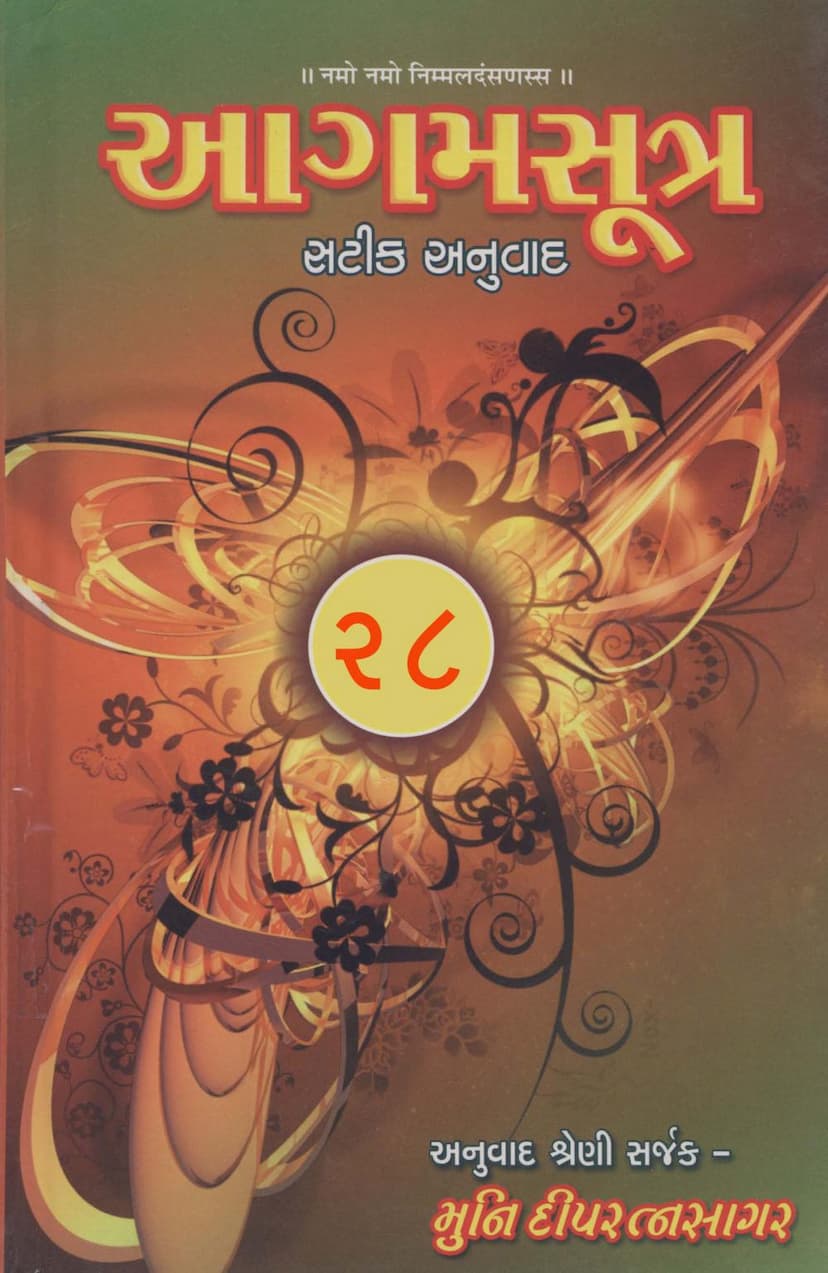Agam Satik Part 28 Nirayavalika Aadi Sutra Gujarati Anuwad 1
Added to library: September 1, 2025

Summary
Here is a comprehensive summary of the provided Jain text, "Agam Satik Part 28 Nirayavalika Aadi Sutra Gujarati Anuwad 1," focusing on its content and structure:
Book Title: Agam Satik Part 28 Nirayavalika Aadi Sutra Gujarati Anuwad 1 Author(s): Dipratnasagar, Deepratnasagar Publisher: Deepratnasagar Catalog Link: https://jainqq.org/explore/009019/1
This volume, part of a larger series of Agama Sutra translations with commentary, is volume 28. It focuses on a selection of Jain Agam texts, primarily from the Upanga and Pañnasūtra categories. The translation and commentary are attributed to Muni Dipratnasagarji M.Sa.
Key Texts Included in this Volume (as per Page 2):
The volume contains a total of 15 Āgamas, categorized into two main groups:
-
Nirayāvalikā-Pañchak (Five Āgamas related to Nirayāvalikā): These are considered Upāṅgasūtras, specifically numbers 8 through 12 in their traditional sequence:
- Nirayāvalikā (Hell-dwellers' Tales)
- Kalpaṃsikā (Celestial Ornaments)
- Puṣpikā (Flower-like Tales)
- Puṣpacūlikā (Flower Crest-jewels)
- Vr̥ṣṇidaśā (Tales of the Vr̥ṣṇi Dynasty) The introduction mentions that a detailed preface to these five Upāṅgasūtras can be found in their previous publications.
-
Daśa Paññā (Ten Paññā-sūtras) + 1 (Optional): These are a collection of ten, with one optional, Paññāsūtras:
- Catuḥśaraṇa (Four Refuges)
- Āturapratyākhyāna (Vow of the Sick)
- Mahāpratyākhyāna (Great Vow)
- Bhaktaparijñā (Vow of Understanding Devotion)
- Tandulavaicārika (Reflections on Grains)
- Saṃstāraka (The Auspicious Mattress/Bed)
- Gacchācāra (Conduct of the Sect)
- Gaṇividhā (Methods of Ascetic Practice)
- Dēvēndrastava (Praise of Indra)
- Vīrastava (Praise of Vira)
- Optional: Candravēdhyaka (Moon-piercer)
Specific Content and Structure (from Page 16 onwards):
The volume begins with the Nirayāvalikā Upāṅgasūtra (the 8th Upāṅga). The text provides a verse-by-verse translation and commentary (vivēcana).
- Nirayāvalikā (Upāṅga 8):
- The initial verses describe the setting: the city of Rajagriha, the Guṇaśīla Chaitya outside it, the Ashoka tree, and the Pṛthvīśilā stone.
- The text then introduces Ārya Sudharmasvāmi, the disciple of Lord Mahāvīr, and his 500 mendicant disciples. It details their wandering and their arrival at Rajagriha.
- The narrative shifts to Ārya Jambū, a disciple of Sudharmasvāmi, and his ascetic practices.
- A significant portion of the early verses and commentary focuses on the historical accounts related to King Konika, his wife Padmavati, and Queen Kāli. It recounts the story of the Rathmusala war and the death of Kāli's son, Kāla Kumāra, and the subsequent events involving Konika and his father Shrenika.
- The later verses delve into the specific meanings of the Paññāsūtras, detailing the commentary for Catuḥśaraṇa (Four Refuges), Āturapratyākhyāna, Saṃstāraka, Gacchācāra, and others. For the Paññāsūtras where commentary is available, it is provided. For others, only the original meaning is given.
- The commentary emphasizes the importance of adhering to the Agamic teachings and the principles of Jain practice. It also mentions specific commentaries used, such as Śrī Candrasūriji's commentary for the five Upāṅgasūtras of the Nirayāvalikā-pañchak and commentaries by Vijayavimal Gaṇi for Catuḥśaraṇa and Tandulavaicārika, and Guṇratnasūri's Avacūrṇi for Āturapratyākhyāna and Saṃstāraka.
Overall Scope:
This volume is a scholarly work that aims to make the complex and ancient Jain Agamas accessible through a Gujarati translation and detailed commentary. It meticulously explains the meanings of the verses, provides context, and elaborates on the philosophical and practical aspects of Jainism as presented in these specific Āgamas. The extensive detail in the commentary suggests a deep dive into the etymology, historical narratives, and ethical teachings embedded within these foundational Jain texts. The author, Muni Dipratnasagarji, is recognized for his extensive work in translating and publishing the entire Agam corpus.